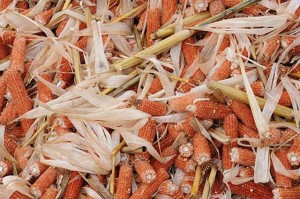 The holy grail of renewable fuels is a commercially viable process for converting cellulosic materials into convenient, combustible liquids that can power cars and trucks. The longstanding challenge is breaking down cellulose into smaller molecules that can be re-assembled into ethanol or other fuels.
The holy grail of renewable fuels is a commercially viable process for converting cellulosic materials into convenient, combustible liquids that can power cars and trucks. The longstanding challenge is breaking down cellulose into smaller molecules that can be re-assembled into ethanol or other fuels.
Cellulose is the stuff of which plants are mostly made, and it’s comprised of a long, tough chains of sugar-like compounds that God created (or nature evolved, if you will) for the express purpose of resisting breakdown.
With their multiple stomachs, cows break down cellulose just fine. The problem is that they (more specifically, the enzymes in their guts) are rather slow about it compared to the rate at which it needs to be digested to supply any meaningful portion of the 160 billion gallons of gasoline we guzzle each year. Those enzymes and the biorefining processes that use them are still quite pricey compared to what it costs to refine petroleum, unless oil gets (and stays) much more expensive than it is today.
Nonetheless, progress is being made. A notable development was recently announced by POET Energy, the nation’s largest ethanol producer. POET has taken its cellulosic ethanol process out of the lab and into a pilot plant now up and running in Scotland, South Dakota, a small town about an hour and a half southwest of Sioux Falls.
The plant started operating late last year and the company just reported that it’s on track to producing 20,000 gallons of ethanol over the coming year. According POET CEO Jeff Broin, “The start-up … has been extremely smooth” and they have “already been able to validate all of what we learned in the lab.” The effort is partly underwritten by the U.S. Department of Energy and is part of a $200 million effort to launch POET’s first commercial scale cellulosic ethanol plant two years from now.
For at least as long as researchers have been trying to crack the nut for cellulosic ethanol, a debate has raged about the pros and cons of ethanol as motor fuel. Fermenting sugars and starches into hooch is thought by some to be the world’s second oldest profession. While today’s biorefineries are certainly more efficient than a moonshine still, the basic process remains the same.
A fundamental problem is that the grains — such as corn kernels — are only a small part of a plant’s total biomass. So relying on fuels from crops of the sort that we can digest means using only a fraction of what gets grown. Converting cellulose enables much better utilization of plant matter for fuel, translating to a lower environmental impact.
Several other companies are experimenting with cellulosic technologies, including Coskata (with whom General Motors has a partnership) and Range Fuels (which has Silicon Valley backing). Both of these firms are start-ups, while POET is a long-established producer with 26 plants in seven states churning out over one billion gallons of conventional, corn-based ethanol annually.
POET’s cellulosic ethanol pilot plant takes in corn cobs. They’re handy because they’re relatively easy to gather and represent only about 15% of the corn stover, the remnants of a harvest that includes stalks and leaves as well as cobs. But cobs are mostly cellulose and so if a process can convert them into fuel, it’s proof that it can also use other forms of cellulose, including wastes. And that would make ethanol that is indisputably green.
